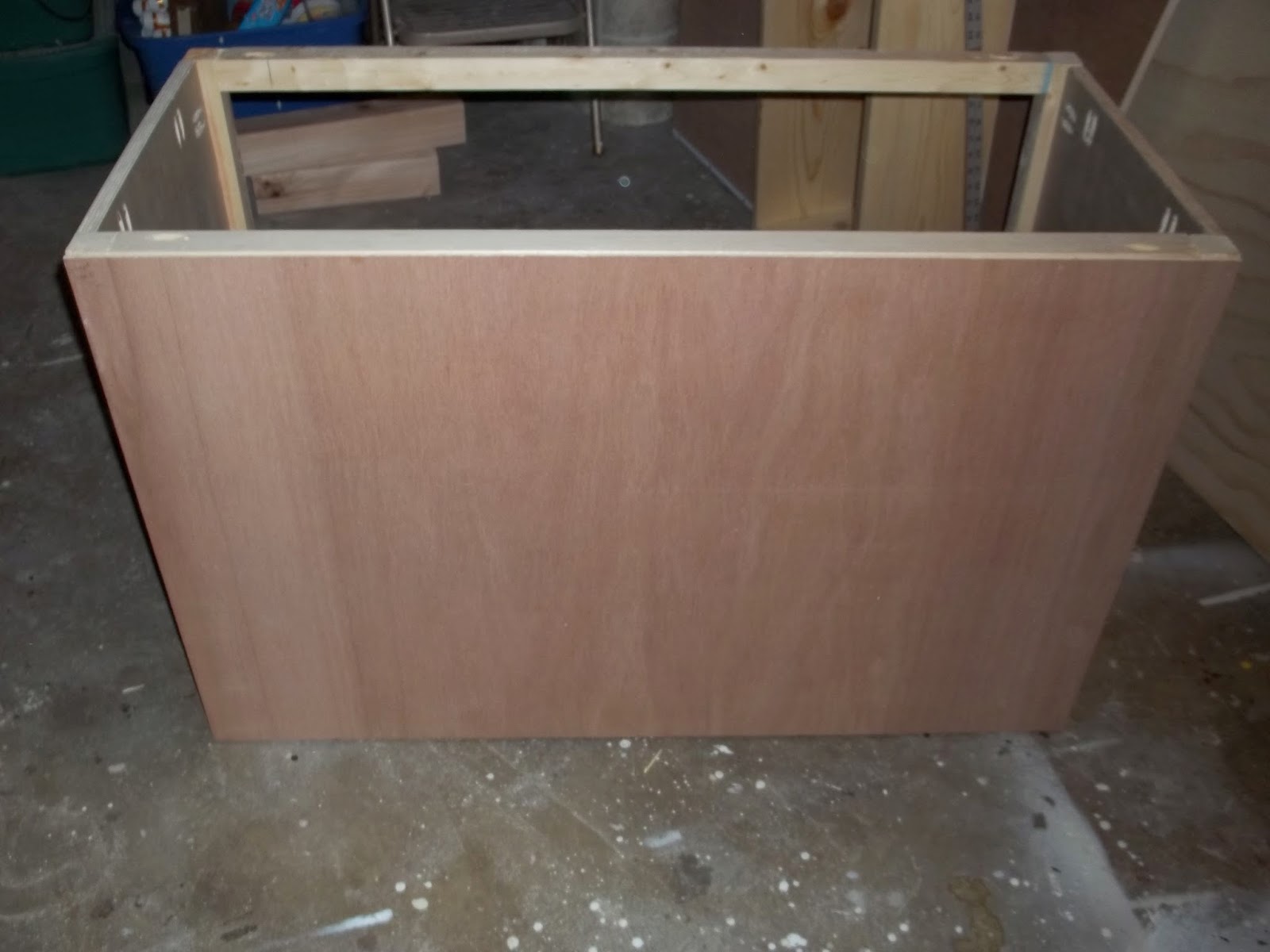Pottery Barn's armoire is 27" deep. I have very limited room in my bedroom, so I decreased the depth. I made mine to have a depth of 19 3/4". If you want the same size as Pottery Barn, you will have to increase the depth.
Needed materials:
1 - 4'x8' 1/4" plywood
1 - 4'x8' 3/4" plywood
2 - 1"x2"
4 - 2"x2"
3 - 1"x10"
1 - 1"x12"
1 1/4" PH screws
2 1/2" PH screws
1 1/4" finishing nails
3/4" finishing nails
1 1/4" wood screws
2 - 16" Bottom Mount Euro drawer slides
4 drawer pulls
4 drawer pulls
Step 1: Make your cuts.
2 - 3/4" plywood at 15 3/4" x 26 3/4" (sides)
4 - 1"x2" at 15 3/4" (drawer slide holders)
4 - 2"x2" at 38 1/2" (top and bottom of frames)
4 - 2"x2" at 26 3/4" (sides of frames)
2 - 1"x2" at 38 1/2" (drawer divider and back middle frame)
1 - 1/4" plywood at 26 3/4" x 41 1/2"(back)
1 - 3/4" plywood at 20" x 42 1/2" (top)
1 - 3/4" plywood at 20" x 42 1/2" (top)
4 - 1"x10" at 36" (drawer fronts and backs)
4 - 1"x10" at 16" (drawer sides)
2 - 1"x12" at 38 1/4" (drawer faces)
2 - 1/4" plywood at 16" x 37 1/2" (drawer bottoms)
2 - 4"x4" at 3" (back feet)
2 - 4"x4" at 3" then cut at a 15 degree bevel (front feet)
I used my circular saw for the plywood cuts and my miter saw for the rest of the cuts.

Step 2: Attach the drawer slide holders to the inside of each side using glue and 1 1/4" finishing nails. Place one 1 1/2" from the bottom. Place the other one 11 1/2" from the top. There will be a 10 3/4" space between the two. Be sure these are level because this is what the drawer slides are going to be attached to.
Step 3: Pre-drill the pocket holes set at the 3/4" setting. Place your pocket holes along the top of the sides to later attach the top. Also, place pocket holes along the sides to attach the frame. You may also choose to place pocket holes at the bottom for later attaching the feet. I was originally not going to put feet on this, but I later changed my mind, so I did not do this at this point.
Step 4: Using 2 1/2" PH screws and setting your Kreg Jig at the 1 1/2" setting, build the front and back frames. Make sure the frames are square. If they are not perfectly square, the drawers will not work properly.
Step 5: Using 1 1/4" PH screws, attach the front and back frames.
Step 6: Using glue and 1 1/4" PH screws, attach the drawer divider in the front. I also added one to the back. I did this just to help keep everything square, but you don't need to add this if you don't want to.
Step 7: Using 3/4" finishing nails, attach the back. This is optional, but since this is the first time that I have attempted drawers, I figured I would add it just to help keep things square. I highly suggest using a back if you are going to make the top portion of the armoire. It will help with the weight.
Step 8: Using 1 1/4" PH screws, attach the top with an overhang of 1/2" on all sides. I also added some finishing nails to hold the top to the 2"x2" frame.
Step 9: Attach the drawer slides to the drawer slide holders following the manufacturer's directions. Be sure to make note of the necessary clearance for the drawer slides. These directions are based off of a clearance of 1/2" on each side. If the drawer slides that you use are different, be sure to adjust the dimensions of your drawer.
Step 10: Using 1 1/4" PH screws, build your drawers.
Step 11: Using 3/4" finishing nails, attach the bottom of the drawers.
Step 12: Following the manufacturer's instructions for the drawer slides, attach the slides to the drawers.
Step 13: Put your drawers in place and then test out the drawer face to make sure it fits. I used 1/8" shims on each side to act as spacers. I then used glue and a few finishing nails to attach the face to the drawer. When I was happy with the placement, I put 1 1/4" screws on the inside of the drawer.
Step 14: Attach the feet. I was not going to put feet on this, so the way I did it was probably not the best way. They should have been attached from the inside to hide the pocket holes. I had to place the pocket holes on the outside. Use 2 1/2" PH screws and glue.
Step 15: Fill any holes with putty and sand it.
Step 16: Paint or finish it. I used Rustoleum Painter's Touch in Kona Brown.
Step 17: Attach the drawer hardware according to the manufacturer's directions. I used Hickory Hardware's Studio Collection Double Bore Cup Pull in the Oil-Rubbed Bronze Highlighted color. They were about $7 each from Menards.
Step 18: Enjoy your new dresser!
This could be used as a stand-alone dresser or as a base to the armoire. I will be adding the tutorial for the top portion of the armoire soon.


























Greaat post thanks
ReplyDeleteBuilding your furniture is a great way to add a personal touch to your space. The Valencia Armoire from Pottery Barn is beautiful, but I understand why you’d want to make one yourself! After all your hard work, get the best sleep possible with a Dreamer 1000 Support Mattress. It’s been incredible for my back, offering excellent support and comfort. Once you’ve completed your furniture, adding a mattress like the dreamer 1000 support Mattress will complete your room!
ReplyDelete